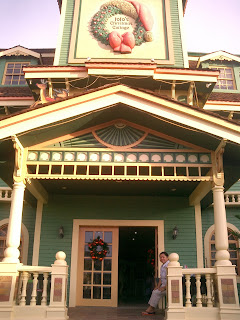As the year draws to an end, it made me wonder how wisely I spent my time and energies this holiday season. After all, as Epicurus once said, "Not what we have, but what we enjoy constitutes our abundance."
While it was felt that this was a more challenging year than most that we've gone through, I am happy to say that my family and I were able to escape all the heavy traffic, the jostling among crowds and crowds in the different malls trying to complete our gift lists, and the general lamentations carried with emptying wallets as the expenses keep coming this holiday season.
For one, it was agreed among friends that we will forgo the gift-giving and just have a wonderful time together with stories and interesting conversation over a meal in some restaurant. It was certainly more enjoyable that way, and Facebook updates were reserved for people who happen to be far, far away.
For another, the opportunity to get out of Metro Manila just as the holiday was coming to a head around Christmas time, was taken in a heart beat.
Indeed, a trip to Cebu was all we needed to simplify things. While Cebu City itself did not escape the holiday rush - traffic was also a problem - we limited ourselves to Mactan and Lapu-Lapu Islands, which also make up the province of Cebu.
As returning guests to Mactan Shangri-La Hotel, it was a welcome opportunity to relive the good memories we have of staying here. The resort hotel has its own claim to the white sands of Cebu's beaches, amenities that included the Chi spa, a playground for toddlers and younger kids, a gameroom or mini arcade for older ones, and private rooms for karaoke/videoke singing (if you are into that kind of thing.)
As a hotel guest, you won't feel like you want to leave the premises, as it is self-sustaining. Nevertheless, a trip to Cebu will not be complete unless you venture outside the hotel and try out the Sutokil restaurants that are just a few minutes' ride away. You won't miss it since it is right beside the Lapu Lapu and Magellan landmarks. Sutukil is short for SUgba, Tula, and KILawin (grill, boil and raw), or the ways in which you can have your food eaten. A Sutukil restaurant means, you pick your seafood or meat fresh from the counter, and instruct the attendants how you want this fish or that prawns cooked.
For our part, we requested our prawns to be cooked with butter garlic sauce, a popular choice. Ours came cooked properly since the shell fell off easily from the meat as we peeled it.
Then we also got one whole Talakitok, a big and flat silver-scaled fish usually good for grilling. Thus, we requested the body to be grilled, and for the head to be cooked into Tula (or tinola in Tagalog). However, Tula in Cebu means it is cooked sinigang style, or with a sour broth, and this means using lemon grass, and little else, as souring agent. This is different from a Tagalog sinigang which uses either tamarind, calamansi (Philippine lime), kamias or even guavas.
Other must-eats would be the baked scallops with a rich, buttery coating, and the fresh seaweed salad, which beads pop the flavors of the sea right in your mouth. All these, while eating among the mangroves and the sea breeze whipping on your face.
We did not go back to the hotel just yet. We walked off that gargantuan meal in the Lapu Lapu shrine next door. We just passed by the many stalls selling souvenir items, as we did on our way to choosing our restaurant at the beginning of the trip. If you are a first-time visitor, go ahead and get yourself a woven bag, shell trinkets, ukeleles or even guitars if you feel like it. After all, Cebu is known for its craftsmanship in guitar-making.
The Lapu Lapu shrine was a welcome respite. It was built in honor of Datu Lapu Lapu, a chieftain of Mactan Island and is known for being the first Filipino to have resisted Spanish occupation and colonization. He fought Ferdinand Magellan and killed him during the Battle of Mactan in 27 April 1521.
A memorial was also built on the spot where Magellan died, although his remains were never returned or surrendered to the Spanish explorers, and thus, remains unknown until now.
This particular trip, however, was not all about eating and lounging around. On another day, we were able to check out 2 department stores in Lapu Lapu Island where we were able to purchase the newest craze in Philippine delicacies, the dried mangoes dipped in chocolate (Php50). The more expensive ones are dipped in Belgian chocolate and contained in attractive boxes (Php230 small/Php680 big).
Another good trip we made was the gift shopping we did for our immediate family members. We went to one of the malls in the area and enjoyed the bargain we got in purchasing brand-name clothes at half the price we would have paid for if we bought it in Metro Manila. The secret, I suppose, is having a friend in the area who just knows where to look.
Thus, to sum this all up: good, helpful friends + desire for simplicity + eye for bargain = a pleasurable holiday.
A joyous New Year to all of you.






























































